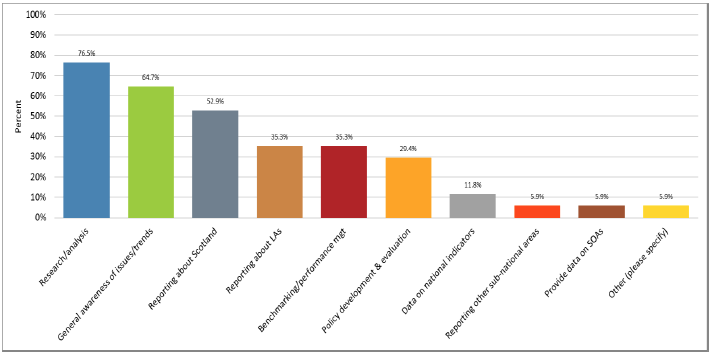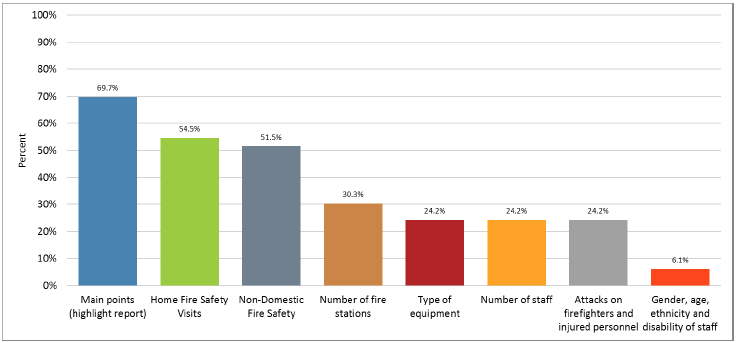Fire Statistics Review
A report on statistics users responses to a consultation on the presentation of fire statistics following transition to a single service.
5. Overview of Fire and Rescue Service Statistics, Scotland
In this overview we wanted to establish how much the Fire and Rescue Service Statistics, Scotland publication is used, which subjects are most important to users and how often they use it.
It is worth reiterating that Fire and Rescue Service Statistics, Scotland is the publication containing information on staffing, fire safety and community safety activity, stations and equipment and attacks on firefighters. Some of the responses indicate that people may have confused this publication with Fire Statistics, Scotland which reports on the incidents the FRS attended.
Just under half of the 33 respondents to the consultation use Fire and Rescue Service Statistics, Scotland and just under half do not, but would consider using it in the future. Six per cent will not.
We asked how users normally view the publication.
| How do you normally view the publication? (please select all that apply) | |
|---|---|
| Online as HTML | 35.3% |
| Online as PDF | 88.2% |
| Printed version of HTML | 0.0% |
| Printed version of PDF | 29.4% |
| Total Respondents | 17 |
Table 8 : Viewing the publication
Most people view the publication online, either as a pdf document or HTML. About a third of users print out the pdf version, though no one prints out the HTML version.
Of the people who said they use the FRS statistics, 70% also use the spreadsheets and another 18% may do, though 12% do not use them.
We asked users how often they use the various topics in the publication. Most use the information annually or quarterly, with few using it more frequently than that.
| Weekly | Monthly | 3 or 4 times a year | Twice a year | Once a year | Never | |
|---|---|---|---|---|---|---|
| Main points (highlight report) | 5.9% | 5.9% | 29.4% | 11.8% | 41.2% | 5.9% |
| Number of fire stations | 5.9% | 0.0% | 17.6% | 35.3% | 17.6% | 23.5% |
| Type of equipment | 5.9% | 0.0% | 17.6% | 23.5% | 29.4% | 23.5% |
| Number of staff | 5.9% | 0.0% | 23.5% | 17.6% | 29.4% | 23.5% |
| Gender, age, ethnicity and disability of staff | 5.9% | 0.0% | 23.5% | 23.5% | 11.8% | 35.3% |
| Attacks on firefighters and injured personnel | 5.9% | 0.0% | 23.5% | 23.5% | 17.6% | 29.4% |
| Home Fire Safety Visits | 5.9% | 5.9% | 35.3% | 29.4% | 11.8% | 11.8% |
| Non-Domestic Fire Safety | 5.9% | 5.9% | 35.3% | 29.4% | 23.5% | 0.0% |
Table 9 : Frequency of use (there were 17 respondents to each question)
We also asked users what they use the information for. Most users stated that they use the data for research and analysis, and keeping up with trends.

Figure 2 : Purpose of the data
The explanation for the response of 'other sub-national areas' is a need for data that covers Scotland, Wales, England and Northern Ireland. The 'other' use of the data was in training and writing publications.
5.1 Changes to publication formatAs with the Fire Statistics, Scotland publication, we are considering reducing the level of detailed information in the commentary section of Fire and Rescue Service Statistics Scotland. We would remove some of the HTML and PDF copies of tables and charts and also refresh the "Commentary" section - summarising key points and statistics. We would continue to provide the more detailed information in the Excel tables, published alongside the main report. This would result in a more concise publication, with the underlying data being more accessible for users to carry out their own analyses.
We asked users if this proposed new publication format would meet their requirements.
90% of respondents said that this would not cause them any problems, though 10% had concerns. These were similar to those expressed for the Fire Statistics, Scotland publication where one respondent cited technical difficulties they have had in the past with Excel spreadsheets on a website and another appreciates the value of a single document which incorporates tables for quick reference, supported by the Excel tables for deeper analysis.
5.2 Prioritising TopicsWe wanted to understand how users prioritise the information currently provided. We asked them to select the 3 topic areas of most value to them.

Figure 3 : Users' priority of the topics
The favourite topic was the Main points followed by home fire safety visits and non-domestic fire safety. Few respondents cited the equalities data as one of their priority topics.
5.3 Changes to data presentationAs with the Fire Statistics, Scotland publication, data will no longer be provided at Fire and Rescue Service level. We asked users whether they want a sub-national breakdown of the Fire and Rescue Service Statistics, Scotland data and what sub-national levels they would find useful for the key fire and rescue service information.
| What level(s) would you find the key fire and rescue service information useful at (please select all that apply)[2]? | |
|---|---|
| Scotland | 23.5% |
| Local Authority | 58.8% |
| Other (please specify) | 17.6% |
| Total respondents | 17 |
Table 10 : Geographic reporting level
Of those who said they would prefer 'other' levels for reporting, one user required both Scotland and local authority level, one would like service delivery area (hub) level and another would like LSO area.
5.3.1 Responsibility for publishing Fire and Rescue Service StatisticsDue to the operational nature of the information contained in Fire and Rescue Service Statistics Scotland, the Scottish Government has proposed that responsibility for this publication should transfer to the Scottish Fire and Rescue Service after the 2013-14 publication. The content and collection method are not expected to change, but a data steering group is planned to oversee the data. While arrangements are yet to be finalised, the Scottish Fire and Rescue Service and their fire board have agreed to this proposal in principle.
We asked users whether this change in responsibility would cause them any concern. 90% said it would not and 10% said it could. The concerns expressed were around data quality and continuation.
5.3.2 More or less dataWe asked users whether there is any information that they would like to see included in Fire and Rescue Service Statistics, Scotland publications in future. 80% of respondents said there was not and 20% said there was.
Three of the requests for extra data referred to incident data and were therefore not relevant to the Fire and Rescue Service Statistics, Scotland publication.
One request was for more simplified reporting of fire safety activity that would better enable benchmarking, and another two were for more detail about fire safety activity, particularly in heritage buildings.
One response related to the recording systems used by the Scottish Fire and Rescue Service and how Scottish Government will work with Scottish Fire and Rescue Service to ensure data sharing is as efficient as possible.
The only response about information users would like to see excluded from Fire and Rescue Service Statistics, Scotland was to say that the times allocated to non-domestic fire safety audits should be excluded because they were too variable.
5.4 General Comments about Fire and Rescue Service Statistics, ScotlandThere were two general comments on the publication, one criticising the reporting of fire safety audits on HMOs and one requesting quarterly updates to align with Scottish Fire and Rescue Service performance management reporting and enabling closer tracking of trends.
Contact
Email: Kirsty Bosley
There is a problem
Thanks for your feedback